日本文化・芸術・服飾・SGDs・リサイクル ― 襤褸(ぼろ)
出典: Hyperallergic 記事 2020年4月29日掲載
<原文>
Japanese Textiles Patched, Used, and Treasured for Generations
by Silvia Benedetti
April 29, 2020
Boro textiles are early examples of sustainability in fashion because of their innovative approach to recycling, and they embody the fundamental principles of wabi-sabi, the Japanese aesthetic that centers on the imperfection of objects.
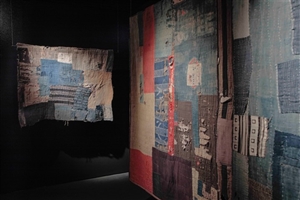
Installation view of Boro Textiles: Sustainable Aesthetics; items from right to left: Bodoko (mat), late Edo to early Showa period, (1800-1950s), hemp and cotton; Kotatsu blanket, late Edo to early Showa period (1800-1950s), hemp and cotton; Aomori Prefecture Amuse Museum/ Chuzaburo Tanaka Collection (all images courtesy Japan Society, New York, and all photos by Richard Goodbody)
During the 19th century, in response to extreme cold weather, peasants in the Tohuku region of northeast Japan developed a unique insulation system for garments and blankets, by reusing readily available materials. They mended, patched, and repaired the same piece as many times as needed for use and reuse by successive generations of the same household. The literal meaning of the word used to describe these textiles, boro, is worn-out cloth, or worthless item, but today the term defines a genre of historical Japanese patchwork garments. These textiles are early examples of sustainability in fashion because of their innovative approach to recycling, and at the same time intrinsically embody the fundamental principles of wabi-sabi, the Japanese aesthetic that centers on the imperfection of objects.
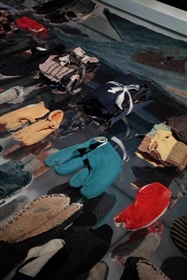
4. Installation view of Boro Textiles: Sustainable Aesthetics; Tabi (split-toed socks). Meiji to Taisho period, (1870-1920s) cotton and various textiles, Aomori Prefecture; Amuse Museum/ Chuzaburo Tanaka Collection
I am glad I was able to see the outstanding Boro Textiles: Sustainable Aesthetics at the Japan Society before New York’s galleries and museums closed due to the COVID-19 pandemic. Organized by curators Yukie Kamiya and Tiffany Lambert, the exhibition presents a variety of vintage garments and accessories that explore the legacy of boro as a traditional handcraft used in contemporary practice, evident in pieces by Rei Kawakubo, Issey Miyake, and Yohji Yamamoto. Undoubtedly the highlight of the exhibition is a selection of traditional Japanese textiles dating from 1800 to the 1950s, from the collection of folklorist and ethnographer Chazaburo Tanaka. A visionary collector, Tanaka appreciated these unique folk art pieces which were traditionally a source of shame for the peasants who made them.
A red, white, and blue donja, (1910-1950s) or night robe, made of hemp and cotton is the first object visible when entering the exhibition. It visually resembles a padded kimono, but actually functions as a duvet or sleeping blanket for an entire family, typically covering a father and mother who would sleep with their children in one communal bed. Its great density - at a weight of 35 pounds - makes the donja able to shut out the cold and wind. The stitching is rudimentary and the insulation is made up of hemp and textile leftovers, yarns, leaves, and straw. According to Kamiya, “This is a kind of creation for and from survival. They have to pile and pile and patch and patch to make it thicker and that’s the result we can see.”
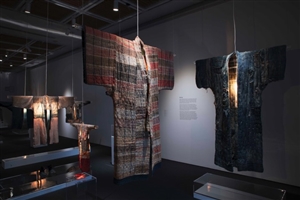
Installation view of Boro Textiles: Sustainable Aesthetics; items from right to left: Donja (night robe) Taisho to early Showa period, (1910-1950s) hemp and cotton; Donja (night robe), late Edo to early Showa period, (1800-1950s), hemp, various textiles. Nanbu Domain, Aomori Prefecture Amuse Museum/ Chuzaburo Tanaka Collection
Hemp used to be the main material employed by farmers and fishermen in northern Japan since cotton was not cultivated in the region, and silk was only available to the privileged class. Most of the vintage textiles in the exhibition are dyed with indigo - which has a pungent smell that protected outdoor workers from mosquitos and other insects. The varying tones of red featured in the exhibited donja were extracted from the expensive and precious benibana flower (safflower) which was found in the north of Japan, though inaccessible to most farmers. If indigo is added to this dye, it is possible to achieve almost any color.
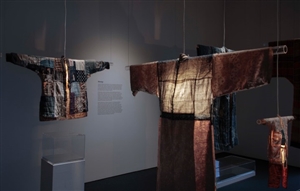
Installation view of Boro Textiles: Sustainable Aesthetics (image courtesy Japan Society, New York, photo by Richard Goodbody)
The inspiration for the installation design by the Brooklyn-based architecture firm SO-IL stems from the idea of showcasing wearable garments linked to ideas of sustainability and recycling. They focused on the presence of the body by giving volume, temperature, and soul to the textiles using lamps. Mirrors placed underneath the garments and accessories reveal different views that otherwise could not be seen. The architects also brilliantly recycled a variety of pedestals, vitrines, and acrylic cases created for past exhibitions at the Japan Society, which would likely have been thrown away.
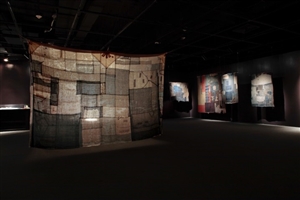
6. Installation view of Boro Textiles: Sustainable Aesthetics; Christina Kim, “Kaya (mosquito net)” (2020) mended and patched textiles
The impact of boro is apparent in the Japanese avant-garde but it is also shown to influence the current generation of artists who experiment with materials, dyeing techniques, and the aesthetic of wabi-sabi which is focused on recognizing and highlighting the beauty in imperfection, impermanence, and the incomplete. New York-based artist Susan Cianciolo stitches and layers existing garments, drawings, textiles, and three-dimensional objects into intuitive tapestries, often working with others, including her daughter. One of her tapestries on view is “Collaboration Textile with Lilac, Donna and Pascale” (1968-2020) in which the patchwork cotton was done by Lilac Sky Cianciolo, the knitted alpaca by Susan Cianciolo, the 1960s quilt by Donna DiPetrillo, and the vintage Guatemalan textile patchwork by Pascale Gatzen. The other contemporary artist in the show is Los Angeles-based Christina Kim who explores rituals and memory through a creative process that reveals the history of an object. For the last fifteen years, together with a network of collaborators, including her students, Kim has reworked, repaired, and mended her ongoing project “Kaya (Mosquito Net)” (2005-2020) which is on view. Both artists also take from boro the utility of collaboration as well as in their respective eco-conscious design fashion and house wear brands RUN, by Cianciolo, and Dosa, by Kim, through which they foster sustainable manufacturing practices.
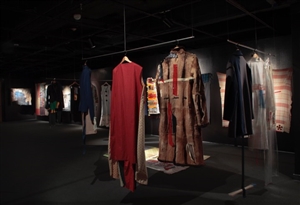
5. Installation view of Boro Textiles: Sustainable Aesthetics Susan Cianciolo, “Run 12: God is a Jacket” (2018)
The materials, process, and ideas around sustainability and recycling developed through Boro Textiles: Sustainable Aesthetics connect not only the past to the present but also the domestic to the global, addressing several reversals: Originally, reuse and recycling was done because of the lack of material and was a source of shame for peasants. Nowadays, it’s a source of shame not to reuse and recycle considering that the fashion sector is one of the major sources of industrial pollution in the world. (Ex: It takes 2,000 gallons of water to make and dye your favorite pair of jeans.) This exhibition doesn’t just tell us about a design practice from the past, it also links them to ideas for a sustainable future.
“Boro Textiles: Sustainable Aesthetics” is scheduled to continue through June 14 at Japan Society (333 E 47th St, Midtown East, Manhattan). Due to the ongoing COVID-19 pandemic, the exhibition is temporarily closed but will be extended. Please check the website www.japansociety.org for updates. The exhibition was curated by Yukie Kamiya with Tiffany Lambert and was organized by Japan Society (New York) in collaboration with Amuse Museum (Tokyo).
Editor’s note: Please note that the Japan Society is currently closed due to the ongoing coronavirus pandemic. Cognizant of the fact that discussions around art and culture remain important during this time, we encourage readers to practice social distancing and self-isolation in an effort to mitigate against the outbreak, which may include opting to explore the exhibition virtually via these resources.
<訳文>
黄色の部分については、この下に掲載してある<訳者からの連絡事項>をご参照下さい。
大切に受け継がれて使用されてきた、日本のつぎはぎの布
シルビア・ベネデッティ
2020年4月29日
斬新な手法で布を再利用する「ボロ」は持続可能な服作りの早期の例であり、そこには、物事の不完全性に重きを置く日本の美学「わびさび」の根本的な理念が具現化されています。

「BOROテキスタイル:継続性の美学」のインスタレーション・展示物(左から):ボドコ(敷物) 江戸後期〜昭和初期(1800〜1950年代) 麻・綿、コタツ布団 江戸後期〜昭和初期(1800〜1950年代) 麻・綿、青森県 アミューズミュージアム/田中忠三郎コレクション(すべての画像:ジャパン・ソサエティー(米国ニューヨーク)、すべての写真:リチャード・グッドボディ)
19世紀に、寒さの厳しい日本の東北地方の農村では、ありあわせの素材をたくみに再利用して衣類やその他厚手の布地の保温性を高めるための手法が編み出されました。同じ布切れを、必要とあらば何度でも繕い、継ぎ当てを施し、そしてまたほころびを直して使用し、親から子へ、子から孫へと受け継ぎ再利用したのです。このような布は「ボロ」と呼ばれます。これは、元々は使い古された布や価値のないものを言い表すために使用される言葉でしたが、今日では、パッチワークが施された歴史的な日本の衣類が形成する一分野を指す用語として用いられています。斬新な手法で再利用されたこれらの布は、持続可能な服作りの早期の例であると同時に、物事の不完全性に重きを置く日本の美学「わびさび」の根本的な理念を本質的に具現化するものです。

4.「BOROテキスタイル:継続性の美学」のインスタレーション・足袋(つま先が別れた靴下)。明治〜大正時代(1870〜1920年代) 綿・その他各種繊維 青森県 アミューズミュージアム/田中忠三郎コレクション
新型コロナウイルス感染症の世界的流行を受けてニューヨークの美術館や博物館が閉鎖される前に、この素晴らしい「BOROテキスタイル:継続性の美学」をジャパン・ソサエティーで鑑賞できたことは幸運でした。キュレーターの神谷幸江氏とティファニー・ランバート氏によって企画された展覧会では、衣類を含むさまざまな古い品々が公開されており、それらを通じて、現代の生活で使用される伝統的な手工芸品としての「ボロ」の遺産を探ることができます。そしてそれは、川久保玲、三宅一生、山本耀司の作品にはっきりと表れています。展覧会の目玉は間違いなく、民俗学者であり民族誌学者である田中忠三郎氏のコレクションから選出された、1800〜1950年代の伝統的な日本の布製品です。これらの際立つ民芸作品は、先見の明を持った収集家の田中氏によって見いだされましたが、そもそも制作者である農家にとっては嘆きの種でした。
入場して最初に目に入るものは、赤、白そして青で染められた「ドンジャ」(1910〜1950年代)です。これは、麻と綿で作られた夜着です。綿入れの着物のように見えますが、実際には家族全員分の夜具(掛け布団)として使用されていたものです。一般的には夫婦とその子供たちが一緒にくるまって寝ていました。重さにして35ポンド(約15.8kg)の、極めて高密度の「ドンジャ」は寒さと風を防いでくれます。基本的な縫い目が施されており、麻くずや繊維くず、紡ぎ糸、葉、わらが中綿として詰められています。神谷氏は述べます。「これは、サバイバルのために生み出されたものであると同時に、生存の結果でもあると言えます。分厚くするために、何度も重ねて継ぎ当てなければならなかったのです。」

「BOROテキスタイル:継続性の美学」のインスタレーション・展示物(左から):「ドンジャ」(夜着) 大正時代〜昭和初期(1910〜1950年代) 麻・綿、「ドンジャ」(夜着) 江戸後期〜昭和初期(1800〜1950年代) 麻・その他各種繊維。青森県南部地方 アミューズミュージアム/田中忠三郎コレクション
北日本で農業や漁業に従事する人々は、麻を主な素材として用いていました。綿はこの地域では栽培されておらず、絹の使用は特権階級に限られていたためです。展示されているほとんどの古布が藍で染められています。藍染めにはツンとした臭いがあるため、屋外での作業時に蚊やその他の虫よけになります。展示されている「ドンジャ」で目を引くさまざまな色合いの赤は、紅花(サフラワー)から抽出されたものです。北日本で採れるものの庶民には手が届きにくかった、高価で貴重なこの染料を藍と組み合わせることによって、ほとんどの色を出すことができます。

「BOROテキスタイル:継続性の美学」のインスタレーション(画像:ジャパン・ソサエティー(米国ニューヨーク)、写真:リチャード・グッドボディ)
ニューヨーク・ブルックリンを拠点とする設計事務所SO-ILが手掛けたインスタレーションのデザインは、サステナビリティとリサイクルの思考につながる、着用に耐えうる衣類を展示するという考えから着想を得たものです。明かりを使用して膨らみ、ぬくもり、そして魂を持たせることによって、布が身体に着せられているように見せることに注力しました。衣類等の品々の真下に置かれた鏡には、下からでないと見ることができない異なる姿が映し出されます。また、過去のジャパン・ソサエティーでの展覧会のために用意された、作品展示用のさまざまな台、ガラスケース、アクリルケースが、廃棄されることなく今回の設計者によってうまく再利用されています。

6.「BOROテキスタイル:継続性の美学」のインスタレーション・クリスティーナ・キム「蚊帳」(2020年) 繕いと継ぎ当てが施された布
日本の前衛美術における「ボロ」の影響は明白ですが、素材や染織技術、そして専ら不完全性、はかなさ、不完全なものにある美しさを認識して強調する「わびさび」の美学を試す現世代のアーティストも「ボロ」から影響を受けていることが見て取れます。ニューヨークを拠点に活動するアーティストのスーザン・チャンチオロは、既存の衣類、線画、布および立体物を縫って重ね合わせ、直感的なタペストリーに仕上げます。自身の娘や他のアーティストと共作することも多々あります。公開されている彼女のタペストリーの一つが「ライラック、ドナ、パスカルとの共作布」(1968〜2020)です。綿のパッチワークはライラック・スカイ・チャンチオロ、編まれたアルパカはスーザン・チャンチオロ、1960年代のキルトはドナ・デ・ペトリロ、そしてビンテージのグアテマラ布のパッチワークはパスカル・ガテンの作品です。展覧会に参加しているもう一人の現代アーティストは、ロサンゼルスを拠点とするクリスティーナ・キムです。彼女は、対象物の歴史を明らかにするクリエイティブな過程を通じて昔の儀式や出来事を探求します。ここ15年間は、自身の教え子を含む協力者たちと共同で、公開中の作品「蚊帳」(2005〜2020年)の手直し、修理、繕いに取り組んでいます。いずれのアーティストも、「ボロ」に見いだした協業の有用性を、環境に配慮したデザインの、ファッションや雑貨のブランドであるRUN(チャンチオロ)とドーサ(キム)にそれぞれ取り入れており、自身のブランドを通じて持続可能な製法を浸透させようとしています。

5.「BOROテキスタイル:継続性の美学」のインスタレーション・スーザン・チャンチオロ「RUN12:ゴッド・イズ・ア・ジャケット」(2018年)
「BOROテキスタイル:継続性の美学」を通して提起されたサステナビリティとリサイクルを取り巻く素材、過程そして思考は、過去と現在をつなぐにとどまらず世界規模で広まる一方、反転に直面しています。再利用やリサイクルは、元はと言えば十分な材料が手に入らないために行われていたのであり、労働者にとって嘆かわしいことでした。今日、世界の産業公害の多くがファッション部門に起因することを考えると、再利用やリサイクルを行わないことは嘆かわしいことです。(例:ジーンズ4本の仕立てと染めには、2千ガロン(7.57立方メートル相当)もの水が費やされます。)本展覧会は過去からのデザイン手法を伝えるのみならず、それらを持続可能な未来への思考につなげるものです。
「BOROテキスタイル:継続性の美学」の展示はジャパン・ソサエティー(マンハッタン ミッドタウン・イースト333 E 47th通り)にて6月14日まで行われる予定です。新型コロナウイルス感染症の世界的流行の影響により展覧会は一時閉鎖中ですが、会期の延長が予定されています。ウェブサイト<www.japansociety.org>にて最新情報をご確認ください。神谷幸江氏とティファニー・ランバート氏によって企画された本展覧会は、ジャパン・ソサエティー(米国ニューヨーク)がアミューズミュージアム(東京)と共同で開催しました。
編集後記:ジャパン・ソサエティーは現在コロナウイルス感染症の世界的流行のため閉鎖されていますのでご注意ください。このような状況においても芸術や文化について議論することは大切なことではありますが、感染症の流行を抑えるために、ソーシャルディスタンスを保って他者との接触を回避していただきたいです。例えば、こちらの媒体を通じて展覧会を仮想訪問してみてはいかがでしょうか。
<訳者からの連絡事項>
| 原文 | 訳文 | 連絡事項 |
|---|---|---|
| leaves, and straw | 葉、わら | 実際に葉やわらがドンジャに詰められていたのかを確認できていません。(敷布団として下に敷かれていたようです。) |